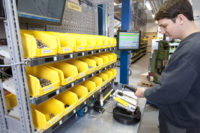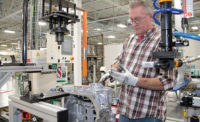It’s not difficult to justify an investment in, say, a dispensing robot or a semiautomatic screwdriving cell. If the machine can produce a certain amount of product, in a set amount of time, at the least amount of cost, and with a minimal level of scrap, it will pay for itself in so many months or years. Done deal.
Justifying an investment in new workstations, lift-assist devices or other ergonomic equipment is a little more difficult. After all, a workstation doesn’t actually make anything. It’s simply a location where assembly, testing or other process can be performed, right? Well, not so fast. The truth is, assemblers can see real bottom-line benefits to investments in workstations and other ergonomic aids, and factorywide ergonomics programs can pay off—big time.
That was the conclusion of a benchmarking study published in August 2014 by ergonomics consulting firm Humantech Inc. The study found that the return-on-investment of a site ergonomics program can exceed three times the investment.
Study Details
For the project, Humantech looked at six U.S.-based Fortune 500 companies—five manufacturers and one utility—with site ergonomics programs. The researchers asked the companies to report metrics for safety, quality, productivity and employee retention. The goal of the study was to quantify the return on investment (ROI) of an ergonomics program at a single location.
“Our goal was to measure the payback of the ergonomics program at a given site,” says Humantech vice president Walt Rostykus. “Over the years, we’ve been able to measure the ROI of engineering controls of specific tasks. However, the payback of an established site ergonomics program remained unknown. This study was our first step in collecting data on the resources that are invested in a site-wide ergonomics program so that we could calculate the financial impact on an organization’s bottom line.
“Historically, health and safety professionals have relied on injury and illness [rates] to measure their ergonomic improvements. We wanted to develop an equation that reliably demonstrates the resulting business value of a program.”
To participate in the study, the six companies completed an online survey that collected information about their programs, including the investment of time, resources, cost and the results achieved.
The companies varied in how long their ergonomics programs had been in place. Two programs had been running for less than three years, but another had been established for more than 10 years. Musculoskeletal disorders (MSDs) accounted for 21 to 82 percent of the companies’ recordable injuries and illnesses. (The average rate was 42 percent.)
All six companies had established a support structure of designated people to oversee their ergonomics programs. The size and makeup of each team varied according to the site culture, need and available resources.
All six had a designated person serving as the ergonomics program lead or manager. In addition:
67 percent had one or more people from the safety staff on the team.
50 percent had one or more senior managers on the team.
67 percent had one or more line employees on the team.
Only two sites had engineers on their ergonomics teams; the engineers accounted for 27 to 60 percent of the people supporting the ergonomics program. This reliance on engineers for managing ergonomics is a best practice identified in previous Humantech benchmarking studies.
Uniquely, one company handed over its ergonomics program to its continuous improvement team.
When comparing the number of ergonomics team members to the overall number of employees at the site, the ratio ranged 1-to-65 to 1-to-120.
Dedicating people with the right skills and roles is important for any ergonomics program. Having those people available to work on the job improvement process is critical. When asked about the time available for leaders to manage the program, half allocated 4 to 8 hours each month.
When asked about the time dedicated for team members and support staff to conduct assessments, lead improvements and attend meetings, most participants (83 percent) indicated fewer than 4 hours each month per person. Similarly, when asked about the time spent each month by engineers to address ergonomic issues with equipment, most participants (83 percent) responded with fewer than 4 hours each month.
All six companies spent money on ergonomics training for team members as well as managers and employees. Training costs varied. For example, team members received training on ergonomic assessment and improvement tools. The cost of such training ranged from $100 to $1,000 per person. Managers and employees were given training on their company’s ergonomics program and the use of observation-based tools. The cost of such training ranged from $100 to $4,000 per site.
All six companies also spent money on equipment and materials to improve ergonomics. In terms of capital expenditures, half had spent between $50,000 and $100,000 in the past 12 months.
Payback Time
Humantech found that ergonomics programs can have beneficial effects not just on injury and illness rates, but also throughput, quality, employee retention and employee engagement.
Three of the six companies reported that their injury and illness rates had decreased since implementing their ergonomics programs. The average annual reduction was 4.9 to 9 percent. Based on the incidence of MSDs and workers’ compensation costs of each site, such reductions saved these companies between $2,977 and $4,854 annually.
Two companies reported no change in their injury and illness rates, and one actually experienced a slight uptick.
Removing ergonomic risk factors from a task often results in higher throughput due to reductions in fatigue and wasted motion. Indeed, three of the six companies reported productivity gains of 10 to 25 percent. Based on the participants’ reports of productivity improvement, the Humantech researchers calculated the value of ergonomic improvements at between $42,538 and $305,833 per year.
Ergonomic improvements can also help remove barriers to quality and improve employee performance. Three of the surveyed companies reported quality improvements since implementing ergonomics programs. Humantech researchers calculated the companies reaped between $12,500 and $25,000 per year in savings.
Improved workplace ergonomics can also help improve employee retention. The study participants reported that the average cost to manage the turnover of one employee ranged from $3,000 to $30,000. The researchers calculated the average value of the impact of ergonomics on improving employee retention to fall between $12,469 and $52,500 per year.
Employee engagement has been recognized as a potential benefit of an ergonomics program, but it is rarely quantified. Although three of the six companies did not measure engagement, one that did reported an increase of 25 to 50 percent.
To calculate the ROI of an ergonomics program, the researchers added the savings from reduced injury rates and improvements in throughput, quality, employee retention and employee engagement. They then divided this total by the cost of implementing the program, including people, training and equipment investments. Ultimately, the researchers found that the ROI of ergonomics programs ranged from 77 to 1,513 percent per year. The average for the group was a 378 percent annual ROI.
Investing in Ergonomics
The results of the Humantech study don’t surprise veteran suppliers of workstations, material handling equipment and ergonomic accessories. They’ve long known that ergonomic investments can yield improvements in productivity, quality and morale.
“Ergonomic investments go hand-in-hand with productivity improvements,” says Kurt Greissinger, vice president of Lean Factory America, a distributor of Green Frame structural aluminum framing, Movexx push-pull assist devices, Delvo electric screwdrivers and other manufacturing products.
Without the help of ergonomic aids, workers might feel fine early in a shift, Greissinger points out. But as the day wears on, and repeated stresses and strains take their toll, those same workers will feel exhausted. Productivity and quality invariably suffer. With ergonomic assist devices, workers will feel less tired and are more likely to perform more consistently.
Sebastian Binnemann, group product manager for Bosch Rexroth Corp., agrees. “Ten years ago, manufacturing was very process oriented,” he recalls. “Processes were perfectly adapted to the product and to high throughput, but sometimes, the workers were forgotten. However, the well-being and happiness of workers plays a big role in how motivated they are.”
Unfortunately, adds Greissinger, most manufacturers are more reactionary than progressive when it comes to investing in ergonomic equipment. “It’s funny,” he says. “When we show our push-pull assist devices to customers, they’re impressed, but then we won’t hear back from them until months later, after someone has been hurt and they need to correct a problem. At that point, it becomes a much easier sell.
“More progressive companies don’t wait for someone to get hurt. They’re always looking ahead to see what’s best for their employees.”
ASSEMBLY ONLINE
For more information on workstations and ergonomics, visit www.assemblymag.com to read these articles:
Workstations: Is Your Assembly Line Ergonomic?
Effective Ergonomics: Some Tips for Assemblers.








